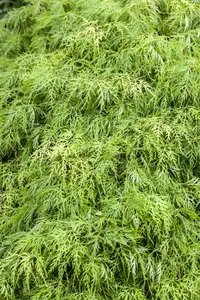Aconitum carm. 'Pershore Abbey' - P9
Aconitum carm. 'Pershore Abbey' - P9
Description
The Monkshood (Aconitum carmichaelii) is a clump-forming perennial that produces blue-violet, funnel-shaped flowers arranged in panicles from August to September. Its palmate leaves are dark green. In a sunny to semi-shady location with well-drained, humus-rich, nutrient-rich soil, it usually reaches a height of approx. 1 m and is approx. 40 cm wide. The Monkshood is well tolerant of frost.
Synonym
Synonyms (botanical): Aconitum fischeri.
Bulletpoints
* Cut flower
* deer resistant
Leaves
The deciduous leaves of the Monkshood are dark green, palmate.
Frost hardiness
The Monkshood has good frost hardiness.
Growth
Nest-forming.
Water
Water regularly and allow the soil to dry out in the meantime.
Location
Preferred location in a sunny to semi-shady position.
Soil
Normal soil.
Planting time
Planting: Autumn, depending on variety also in spring.
Planting partner
The Monkshood sets beautiful accents together with:
Garden autumn anemone.
Care
The faded inflorescences should be cut back. This measure encourages new growth.
Flower
Aconitum carmichaelii forms funnel-shaped, blue-violet flowers arranged in panicles from August.
Interesting facts
Aconitum carmichaelii is categorised as a highly poisonous plant.
Use
Cut, woodland edge, herbaceous border
- Article number53
-
EAN codeACCPABBE-0P9
- Latin nameAconitum carm. 'Pershore Abbey'
- catalogLandscape shop



